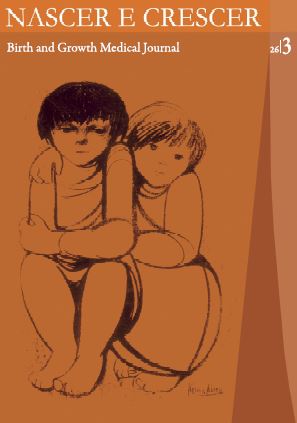Spontaneous pneumomediastinum: report of two cases
DOI:
https://doi.org/10.25753/BirthGrowthMJ.v26.i3.13493Keywords:
Asthma, children, pneumonia, spontaneous pneumomediastinum, subcutaneous emphysemaAbstract
Introduction: Spontaneous pneumomediastinum is a rare clinical condition in childhood that occurs in most cases with exacerbations of asthma. The most common symptoms are chest pain and dyspnea. Diagnosis is usually made by chest radiography. Conservative treatment is preferred with a favorable prognosis.
Case reports: The first case, a 14-year-old boy with spontaneous pneumomediastinum and subcutaneous emphysema diagnosis, without triggering factor, despite history of asthma. The second one, a 19-month-old boy who developed, as a complication of pneumonia, a spontaneous thoraco-cervical pneumomediastinum and pneumothorax. The evolution was favorable, in the first case only with symptomatic treatment and in the second, progressive respiratory improvement was observed, after a chest drain insertion.
Discussion/Conclusions: These cases are examples of spontaneous pneumomediastinum that highlights the rarity of this disease in this age group.
Downloads
References
Hamman L. Spontaneous mediastinal emphysema. Bull Johns Hopkins Hosp 1939; 64: 1-21.
Macklin, CC. Transport of air along sheaths of pulmonic blood vessels from alveoli to mediastinum: clinical implications. Arch Intern Med 1939; 64: 913-26.
Dekel B, Paret G, Szeinberg A, Vardi A, Barzilay Z. Spontaneous pneumomediastinum in children: clinical and natural history. Eur J Pediatr 1996; 153: 695−7.
Panacek EA, Singer AJ, Sherman BW, Prescott A, Rutherford WF. Spontaneous pneumomediastinum: clinical and natural history. Am Emerg Med 1992; 21: 1222−7.
Abolnik I, Lossos IS, Breuer R. Spontaneous pneumomediastinum: a report of 25 cases. Chest 1991; 100: 93−5.
Chalumeau M, Le Clainche L, Sayeg N, Sannier N. Michel JL, Marianowski R., et al. Spontaneous pneumomediastinum in children. Pediatr Pulmonol 2001; 31: 67−75.
Stack AM, Caputo GL. Pneumomediastinum in childhood asthma. Pediatr Emerg Care 1996; 12: 98-101.
Roe PF, Kulkarni BN. Pneumomediastinum in children with cough. Br J Dis Chest 1967; 61: 147-50.
Yellin, A, Gapany-Gapanavicius, M, Lieberman, Y. Spontaneous pneumomediastinum: is it a rare cause of chest pain? Thorax 1983; 38: 383-85.
Chu CP, Chen PP. Tracheobronchial injury secondary to blunt chest trauma: diagnosis and management. Anaesth Intensive Care 2002; 30: 145-52.
Al-Mufarrej F, Badar J, Gharagozloo F, Tempesta B, Strother E, Margolis M. Spontaneous pneumomediastinum: diagnostic and therapeutic interventions. J Cardiothorac Surg. 2008;3:59.
Macia I, Moya J, Ramos R, et al. Spontaneous pneumomediastinum: 41 cases. Eur J Cardiothorac Surg 2007; 31: 1110-14.
Herlan DB, Landreneau RJ, Ferson PF. Massive spontaneous subcutaneous emphysema. Acute management with infraclavicular ‘‘blow holes’’. Chest 1992; 102: 503-5.
Downloads
How to Cite
Issue
Section
License
Copyright and Authors' Rights
All articles published in Nascer e Crescer - Birth and Growth Medical Journal are Open Access and comply with the requirements of funding agencies or academic institutions. For use by third parties, Nascer e Crescer - Birth and Growth Medical Journal adheres to the terms of the Creative Commons License "Attribution - Non-Commercial Use (CC-BY-NC)".
It is the author's responsibility to obtain permission to reproduce figures, tables, etc. from other publications.
Authors must submit a Conflict of Interest statement and an Authorship Form with the submission of the article. An e-mail will be sent to the corresponding author confirming receipt of the manuscript.
Authors are permitted to make their articles available in repositories at their home institutions, provided that they always indicate where the articles were published and adhere to the terms of the Creative Commons license.


